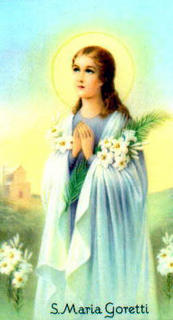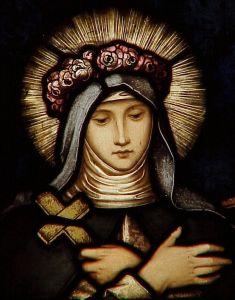
Saint Maria Goretti 1890-1902
Martyr of Purity
Patronage : against impoverishment, against poverty, girls, loss of parents, martyrs, rape victims, young people in general.
A girl’s real beauty is within. It is a thing of her soul, shining through her pure eyes and radiating her whole body. It is something by which she makes men aware of the truth and beauty and goodness of God by reflecting that beauty and goodness in herself.
The daughter of humble sharecroppers, Maria and her family moved to the little town of Ferriere, Italy in 1899 in search of work . Misery followed them but hope was adamant. Desperately seeking to support his family, Luigi Goretti struck up a bargain with Signor Serenelli, who had a son named Alessandro. The two families lived together in a building.
Maria quickly matured in grace and holiness in the eyes of friends and other acquaintances. After losing her father to malaria, she developed great strength and maturity. Her charming modesty, cheerful obedience and the serious, but free acceptance of a hundred thankless home chores distinguished her from the other children who would play in the dusty streets of Ferriere. The highlight of her life was her First Holy Communion, which she dutifully prepared for and awaited with great anticipation. She truly seemed to be advancing "in wisdom, and age and grace before God and men."
Lured by the passions of his day and nurturing the dark side of his soul with impious reading and thoughts Allesandro had been a thorn in lovely Maria's side. He propositioned her on several occasions and harassed her with impure suggestions. On July 5, 1902, he would be denied no longer. As she once again rebuffed his sexual advance, shouting, "No! It is a sin! God does not want it!". He tried to choke her into submission, then stabbed her fourteen times. She resisted until the very end.
Doctors in Nettuno tried to save Maria's life to no avail. On her dying bed her soul was ready for her final tryst with God but there was one last deed to be done. She reflected on the crucifix on the wall and said “for the love of Jesus I pardon him and I want him to be with me in Heaven”
After 20 painful hours of suffering during which she forgave and prayed for Alessandro, Maria entered Heaven fortified with the Last Sacraments. The priest who came to give Maria her Last Sacrament placed a medallion of the Blessed Mother around her neck. She kissed the picture of the Holy Virgin on the medallion and prayed in the words that Catharine Labouré was given by Our Lady:
MARY CONCEIVED WITHOUT SIN, PRAY FOR US WHO HAVE RECOURSE TO THEE"
Her last earthly gaze rested upon a picture of the Blessed Mother on July 6, 1902.
Maria Goretti died a martyr before her twelfth birthday. Young as she was, she made a choice, a choice based on her faith. The Church holds up to the world the life, death and the faith of Maria Goretti
While in prison for his crime, Allessandro had a vision of Maria. He saw a garden where a young girl, dressed in white, gathered lilies. She smiled, came near him, and encouraged him to accept an armful of the lilies. As he took them, each lily transformed into a still white flame. Maria then disappeared. This vision of Maria led to Alessandro's conversion, and he later testified at her cause for beatification.
Almost fifty years later on June 24, 1950, Pope Pius XII stood on the steps of St. Peter's in Rome and pronounced Maria Goretti a Saint and Martyr of the Universal Church to half a million people. He proposed her as the Patroness of Modern Youth and set July 6th as her feast Day. Her mother, and her murderer, attended the canonization ceremony together.
This was the triumph of the little girl who loved God and hated sin. Maria Goretti had led a very ordinary life. But in spite of her simplicity, her great faith and love for God made her truly extraordinary. She is the voice of Mary recalling the church to Prayer and Penance and Heroic Virtue. In addition, it was her special vocation to live the uncompromising absolute: to choose to die rather than to sin, and to become the shining lovely saint of Purity. Everything in her life prepared her to be the special instrument of the Holy Virgin.
Although she was poor and deprived of a school education, Maria, who was not yet 12 years old had a strong and mature personality, shaped by the religious instruction she had received in the family. This shows the importance of teaching our children the faith and it made her capable not only of defending herself with heroic chastity, but even of forgiving her murderer.
Each generation is taught by an earlier generation...if we are skeptical we shall teach only skepticism to our pupils, if fools only folly, if vulgar only vulgarity, if saints sanctity, if heroes heroism...Nothing which was not in the teachers can flow from them into the pupils. (C.S.Lewis )
Her martyrdom reminds us that the human being is not fulfilled by following the impulses of pleasure but by living life with love and responsibility. Her martyrdom reminds us that the human being is not fulfilled by following the impulses of pleasure but by living life with love and responsibility Maria was given the name of Our Lady. May the purest of human creatures help the men and women of our time, and especially young people, to rediscover the value of chastity and to live interpersonal relations in reciprocal respect and sincere love.
Maria's story is powerful. It echoes Pope John Paul II's cry to today's youth- "do not be afraid to be saints!" We must not be afraid to learn who Christ is, to forgive like Him, to see our own sexuality and personal integrity in the light of Christ even if that is different to our contemporaries.
